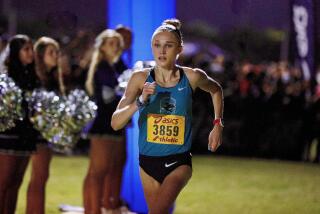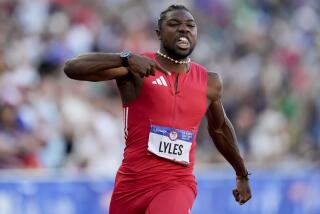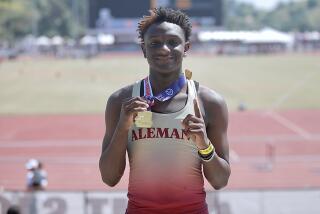Glusac, Das Neves at Home for National Meet : Cross-country: Local runners have done well at Balboa Park’s Morley Field.
- Share via
SAN DIEGO — They’re going to have to start holding this thing at a neutral site one of these years.
The Kinney National Cross-Country Championships, now in its 13th year, has adopted Balboa Park’s Morley Field as home.
But Morley Field is also something of a home setting for Fallbrook junior Milena Glusac and Helix junior Daniel Das Neves, both of whom won Section championships there only three weeks ago.
They return Saturday seeking the only national championships of any high school sport. The girls’ race begins at 10 a.m., the boys’ 45 minutes later.
It’s not as though either Glusac or Das Neves needs a home-course advantage.
After her performance in the Western Regional last week in Fresno, Glusac would be favored to win even if the race were held in Ketchikan, Alaska. And Das Neves, the only 19-year-old in the race, has not only displayed a killer instinct in big races of the past, but also trains under internationally renowned distance coach Luiz de Oliveira and alongside world-class runners Joaquim Cruz and Jose Barbosa.
Despite finishing sixth at the regional, where he ran only to finish among the top eight in order to qualify, Das Neves expects to be in the thick of things Saturday. One reason why is his familiarity with twists, turns, ascents and descents of Morley Field.
“I know the course already,” he said. “I’m going to go for it. I’m going to try to win. I know the pace will be fast--under 15 minutes (over 5,000 meters)--but I’ll be in the top three the whole time and at the end I’ll be in position to win.”
Glusac is slightly more bashful--she never predicts where she will be at the end of a race, though she has never lost this year.
At last week’s regional, which provided her with more competition than she has seen all season, Glusac won by 75 yards in 17 minutes 11 seconds.
There will be even stiffer competition Saturday and Glusac is looking forward to it.
“It always helps when you have someone there along side you because with someone else pushing you, you’re forced to go faster just to stay with them.”
Of course, Glusac need not worry about running in Ketchikan--there’s no course on the Alaskan island near the southeasternmost tip of the state.
But there is a Kinney qualifier, Gretchen Klein, a senior who must deal with some unusual adversity just to train.
The sun shines on Ketchikan only eight hours a day this time of year, and not at all at 4 a.m. when Klein begins her morning workout on the only pavement in own, the Tongass Highway, a logging road which stretches only 30 miles.
Her coach, Dick Clevenger, drives behind Klein with his high beams pointing the way and warding off logging trucks.
“They (drivers) are a little more courteous now that they know I’m out there,” Klein said. “But still, when they come speeding around corners, I definitely move over. They go by a little too fast.”
At that early hour, more than trucks lurk in the darkness. The area’s indigenous black bears are out there, too, but Klein avoids them by training far from the town dump, the bears’ favorite hangout.
Although the temperature is mild for Alaska (Klein says it averages 40 degrees in the winter, but dips as low as 20), the area gets about 150 inches of rain per year and is often swept by winds of 80 m.p.h.
Perhaps Klein’s biggest disadvantage is Alaska’s high school cross-country season, which begins in August and concludes with the state meet at the end of September. The Kinney Regionals are not held until early December, which forces Klein to train without the benefit of a meet for six weeks.
Despite the hindrances of training in Alaska, Klein insists she is not handicapped, though she was disappointed with her eighth-place showing (17:56) at the Western Regional.
“I was hoping to do better,” Klein said. “I only improved my time from last year by four seconds. My times were 30 seconds better during the cross-country season.”
Another top competitor in the girls’ race will be Amanda White, a junior at Delaney High in Cockeysville, Md. This is only the second year White has run cross-country.
Last year she concluded her first season by finishing third at the Kinney National. She was the first underclassman to cross the line.
White is also a top national swimmer. In fact, after placing second in the Nov. 30 Northeast Regional at 17:51, she hopped on a plane for Minneapolis where she competed the next day at the U.S. Swimming Championships. She missed earning a berth to the U.S. Olympic Swim Trials by placing 20th in the 200-yard breaststroke.
Although she was favored to win the Northeast Regional and hoped to gain entry to the Olympic trials, White insisted that she did not wear herself down by simultaneously training for two grueling events.
On the contrary, White said, “it gives me endurance.”
Liz Mueller, a junior at Waterford (Conn.) High, was the surprise winner of the Northeast Regional, completing the course in 15:38.
Mueller, however, is not an unknown. As a freshman two years ago, she placed seventh at the Kinney National, but last year failed to qualify after running in the regional with the flu.
Other top contenders include Megan Flowers, a senior at Trinity Valley High in Fort Worth, Texas, and the top finisher at the South Regional (17:46), and Meghan McCarthy, a senior from Robinson High in Burke, Va., and the third-place finisher at the South Regional (18:10). Both are four-time Kinney qualifiers.
In the boys’ race, Jama Bile, a senior at Fork Union Military Academy in Fairfax, Va., is expected to run in the lead pack, which could number as many as 10 runners in what should be the closest race in Kinney history.
Bile finished second in the Northeast Regional (15:19), four seconds behind winner Marc Davis, a senior at Spartanburg (S.C.) High.
After losing his right shoe at the beginning of the race, Bile continued without it. Still, he had meet officials wondering if there was a bigger problem when with 150 meters to go he was wincing in pain.
The officials knew that running barefoot was nothing new to Bile, who grew up running without shoes in Somalia.
Bile limped across the finish line with a bloodied foot. Race officials thought it was the result of the gravel course but then winced themselves as they watched Bile matter-of-factly reach down and yank a fishing hook out of his heel.
“With about a mile and a half to go I felt something sticking into my foot,” Bile said. “I didn’t know what it was and I couldn’t stop. By the end of the race it hurt so bad I couldn’t even put my foot on the ground.”
Bile is the younger brother of 1989 World Cup 1,500-meter champion Abdi Bile.
More to Read
Get our high school sports newsletter
Prep Rally is devoted to the SoCal high school sports experience, bringing you scores, stories and a behind-the-scenes look at what makes prep sports so popular.
You may occasionally receive promotional content from the Los Angeles Times.






